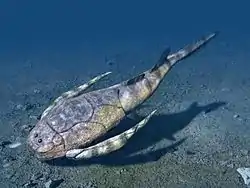Mohanamico
Mohanamico is an extinct genus of New World monkeys from the Middle Miocene (Laventan in the South American land mammal ages; 13.8 to 11.8 Ma). Its remains have been found at the Konzentrat-Lagerstätte of La Venta in the Honda Group of Colombia. The type species is M. hershkovitzi. Due to the relatively few material found of Mohanamico, the placement of the genus is not certain and three possible families have been proposed by different authors, Callitrichidae, Pitheciidae or Aotidae.
| Mohanamico | |
|---|---|
| Scientific classification | |
| Kingdom: | Animalia |
| Phylum: | Chordata |
| Class: | Mammalia |
| Order: | Primates |
| Suborder: | Haplorhini |
| Infraorder: | Simiiformes |
| Family: | Pitheciidae |
| Subfamily: | Pitheciinae |
| Genus: | †Mohanamico Luchterhand, Kay & Madden 1986 |
| Type species | |
| †Mohanamico hershkovitzi | |
Etymology
Mohanimico hershkovitzi is named after the river god Mohan of the Magdalena River, in which valley the fossils were found and to honor Philip Hershkovitz for his contributions to the study of Colombian and other South American primates.[1]
Description
Fossils of Mohanamico were discovered in the "Monkey Beds" of the Honda Group, that has been dated to the Laventan, about 12.5 Ma.[2] Mohanamico was about the size· of the living squirrel monkey Saimiri sciureus. Its molars are low-crowned and the molar crests are not pronounced suggesting a frugivorous diet like Aotus. The lateral incisor is large and high-crowned, which foreshadows living Pitheciidae. The canines and Pz were large and sharp like Callimico. Analysis of the mandible and teeth suggest that Mohanamico] is a primitive member of the Pitheciidae. Some similarities with Callimico and Saguinus are also noted raising the possibility that pithecines and callitrichids are monophyletic.[3]
The estimated weight of Mohanamico was 1,000 grams (2.2 lb),[4] similar in size to Aotus dindensis found in the same location.[5] The Argentinian genus Homunculus had smaller molars than Mohanamico.[6]
Some authors place Mohanamico in the Callitrichidae,[7] possibly related to the Callimico clade, based especially on its taller incisors and canines, large p2, and broader and longer trigonid in proportion to the talonid.[8] Other authors dispute this and consider the genus more likely a Pitheciidae,[9] or possibly an Aotidae.[10] If placed within the Pitheciidae, the primate would be at the base of the evolutionary radiation because of the large incisors and the structure of its canines and premolars.[11]
Habitat
The Honda Group, and more precisely the "Monkey Beds", are the richest site for fossil primates in South America.[12] It has been argued that the monkeys of the Honda Group were living in habitat that was in contact with the Amazon and Orinoco Basins, and that La Venta itself was probably seasonally dry forest.[13] From the same level as where Mohanamico has been found, also fossils of Cebupithecia, Micodon, Saimiri annectens, Saimiri fieldsi and Stirtonia have been uncovered.[3][14] From the same location, a fossil specimen of the fish tambaqui (Colossoma macropomum) was recovered.[3]
References
- Luchterhand et al., 1986, p.1757
- Wheeler, 2010, p.133
- Luchterhand et al., 1986, p.1753
- Silvestro, 2017, p.14
- Gebo et al., 1990, p.738
- Luchterhand et al., 1986, p.1756
- Tejedor, 2013, p.29
- Pérez et al., 2013, p.4
- Wheeler, 2010, p.134
- Takai et al., 2001, p.303
- Defler, 2004, p.33
- Rosenberger & Hartwig, 2001, p.3
- Lynch Alfaro et al., 2015, p.520
- Setoguchi et al., 1986, p.762
Bibliography
- Defler, Thomas. 2004. Historia natural de los primates colombianos, 1–613. Universidad Nacional de Colombia. Accessed 2017-09-24.
- Gebo, Daniel L.; Marian Dagosto; Alfred L. Rosenberger, and Takeshi Setoguchi. 1990. New platyrrhine tali from La Venta, Colombia. Journal of Human Evolution 19. 737–746. Accessed 2017-09-24.
- Luchterhand, Kubet; Richard F. Kay, and Richard H. Madden. 1986. Mohanamico hershkovitzi, gen. et sp. nov., un primate du Miocene moyen d' Amerique du Sud. Comptes rendus de l'Académie des sciences 303. 1753–1758. Accessed 2017-09-24.
- Lynch Alfaro, Jessica W.; Liliana Cortés Ortiz; Anthony Di Fiore, and Jean P. Boubli. 2015. Special issue: Comparative biogeography of Neotropical primates. Molecular Phylogenetics and Evolution 82. 518–529. Accessed 2017-09-24.
- Rosenberger, Alfred L., and Walter Carl Hartwig. 2001. New World Monkeys. Encyclopedia of Life Sciences _. 1–4. Accessed 2017-09-24.
- Setoguchi, Takeshi; Nobuo Shigehara; Alfred L. Rosenberger, and Alberto Cadena G. 1986. Primate fauna from the Miocene La Venta, in the Tatacoa Desert, Department of Huila, Colombia. Caldasia XV. 761–773. Accessed 2017-09-24.
- Silvestro, Daniele; Marcelo F. Tejedor; Martha L. Serrano Serrano; Oriane Loiseau; Victor Rossier; Jonathan Rolland; Alexander Zizka; Alexandre Antonelli, and Nicolas Salamin. 2017. Evolutionary history of New World monkeys revealed by molecular and fossil data. BioRxiv _. 1–32. Accessed 2017-09-24.
- Takai, Masanaru; Federico Anaya; Hisashi Suzuki; Nobuo Shigehara, and Takeshi Setoguchi. 2001. A New Platyrrhine from the Middle Miocene of La Venta, Colombia, and the Phyletic Position of Callicebinae. Anthropological Science, Tokyo 109.4. 289–307. Accessed 2017-09-24.
- Tejedor, Marcelo F. 2013. Sistemática, evolución y paleobiogeografía de los primates Platyrrhini. Revista del Museo de La Plata 20. 20–39. Accessed 2017-09-24.
- Wheeler, Brandon. 2010. Community ecology of the Middle Miocene primates of La Venta, Colombia: the relationship between ecological diversity, divergence time, and phylogenetic richness. Primates 51.2. 131–138. Accessed 2017-09-24.
Further reading
- Croft, Darin A. 2016. Horned Armadillos and Rafting Monkeys: The Fascinating Fossil Mammals of South America, 1–320. Indiana University Press ISBN 9780253020949. Accessed 2017-10-21.
- Fleagle, John G., and Alfred L. Rosenberger. 2013. The Platyrrhine Fossil Record, 1–256. Elsevier ISBN 9781483267074. Accessed 2017-10-21.
- Hartwig, W.C., and D.J. Meldrum. 2002. The Primate Fossil Record - Miocene platyrrhines of the northern Neotropics, 175–188. Cambridge University Press, ISBN 978-0-521-08141-2. Accessed 2017-09-24.


.jpg.webp)
